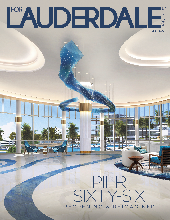Quietly flowed the New and Middle rivers, like something out of a Russian novel, until the Army engineers arrived.
They drained the Everglades and constructed those straight canals that run west to east. Then came The Big Dig, stretching from Maine to Key West and redirecting and connecting natural north-south waterways. Soon land developers appeared on the scene, forming “finger isles” from the muck and mangroves for the future homes of millionaires. That, in a nutshell, is where we are today, waterwise.
Of course, none of this happened overnight, and none of it happened without struggles of all sorts. For example, those first isles off Las Olas were created by developers in the land boom of the 1920s, which ended in a bust. The land that today holds magnificent, yacht-fronted homes lay fallow for a decade – long enough for pine groves to sprout. They disappeared when the economy picked up in the late ’30s and building began again.
The development of the Intracoastal Waterway is documented in Florida’s Big Dig by William Crawford Jr., local attorney and historian. The book tells the story of endless hearings and all kinds of fits and starts across the decades as canal companies and regional authorities tried to keep the project funded.
Originally, the New and Middle rivers flowed into what was called the New River Sound, emptying into Lake Mabel. The waters of Lake Mabel escaped over sandbars and silt into the ocean, and also farther south at a natural inlet (now closed) near today’s Sheridan Street in Hollywood.
When dredgers came, the sound became part of the Intracoastal Waterway. Later, Fort Lauderdale and Hollywood city fathers teamed up to deep-dredge Lake Mabel and make the cut to the ocean. In 1928, to much fanfare, Bay Mabel Harbor was dedicated as the area’s first deep-water port. In a contest held shortly thereafter, The Woman’s Club came up with the name that sticks today: Port Everglades.
Lots of harebrained ideas came along with the successes. In the early days of the Intracoastal, for example, chains were stretched across the water at selected points all the way up the state. To gain passage, cargo and passenger boats had to stop midstream and pay tolls. Thankfully, this process was eventually found to be more trouble than it was worth.
The phrase “The Venice of America” is not something a marketing genius came up with. Real estate investor Charley Rodes consciously adopted techniques used in the city of Vivaldi and Bellini to build his isles off of Las Olas Boulevard. And because of this he wanted the area to be named “Venice.” Meanwhile another developer, W.F. Morang, was doing the same thing over in Rio Vista. According to historian Susan Gillis, the draining of canals was “relatively inexpensive” and eliminated “the breeding grounds for two of the least attractive features of Fort Lauderdale life: mosquitoes and sandflies.”
In no accounts of all this was there an environmentalist to be found, although there was probably a Seminole out there thinking, “What the heck are these fools doing now?” The word environmentalist did not come into common usage until 50 years after the Everglades draining. Whoops, did we destroy the ecology and our water system? Did some of that land we drained disrupt the Seminole way of life?
Meanwhile, less collateral injury was done on the other side of the Intracoastal, to our gem of a beach. As has been noted here before, it was once accessible only by a motor launch operated by Frank Stranahan. Our first real bridge, at Las Olas, was built in 1917. The bridge over Sunrise followed two decades later.
So there’s the story of our Venice without a Renaissance. While there were costs, no one can deny our breezy tropical tapestry – those miles and miles of gorgeous waterways.













2 comments
Thank god some smart people saved the beach and Hugh Taylor gave us his land and the Bonnet House. What truly makes us special is not concrete,aspalt,steel, or lawns…but our nature.
Sadly. Not anymore. I was shocked to learn that we are among the rare few locations that have a beach that we can drive along. Mia the old days. No meters.